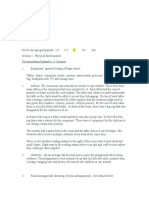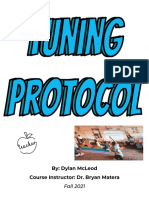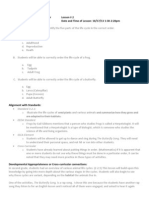Tws 1-Contextual Factors Weebly
Uploaded by
api-176731501Tws 1-Contextual Factors Weebly
Uploaded by
api-176731501A. Classroom Factors The classroom is arranged into three table sections, or groups.
Group one has eight students at the table, group two has four students, and group three seats eight students. The shape of these tables creates a U shape, allowing the teacher to stand in the middle and address all the students with equal attention. Each student has an individual area attached to the bottom of their table where they may store supplies. There are a set of cubbies that line the wall adjacent to the entrance to the classroom; housing the book bag rack underneath them. The back wall of the classroom is lined with cabinets and shelves holding books, writing materials, paper, and a multitude of other resources. Directly under these shelves are five computers, with one printer. Students are able to use these during specified times; for example, to complete math lessons/games that are tailored to their ability level. There is a sink/water fountain at the end of this counter, which holds the computers. Right next to this is a bathroom for the students. Along the next adjacent wall are two windows, and in the corner sits the teachers desk. Along the front wall is a white board, with daily routines and schedules, as well as that nights homework on display. Right next to this is a Smartboard. In front of the Smartboard is a rug area where the students sit during lessons and reading times. Underneath the Smartboard sit baskets, each labeled with an RTI number, with books corresponding to that level inside them. Finally, sits a kidney shaped table where the teacher spends a majority of his time, when not teaching or walking around helping/observing students work. The shape of this table, as well as the 4 stools that sit around it allow him to help numerous students at one time. Parent Involvement The lines of communication between the teacher and parent are kept very open. There is a folder that goes home weekly with the students work from that week, and parents are required to sign these. This ensures the parents are up to date on how their students are preforming in class, so intervention can happen as soon as possible, if necessary. Parents are invited to set up conferences as necessary, and the teacher is very flexible and willing to work with parents schedules in order to help meet their needs. While the teacher is more than willing to communicate with parents in order to ensure their childs success, it seems as though parents may not be very involved. This is speculation, but there were only 4 out of 20 students parents that made it to open house. This could have been due to scheduling conflicts however. Classroom Schedule: 7:35-8:00 8:00-9:05 9:05-9:55 9:55-12:20 Breakfast/WMER/Morning Work MATH RELATED ARTS ELA BLOCK
10:00-10:20 10:20-11:10 11:10-11:30 11:30-12:20 12:20-12:50 12:50-1:10 1:10-1:30 1:30-2:30 2:30
Interactive Read Aloud Reading Workshop Shared Reading/ Word Study Writing Workshop
LUNCH Recess Language/RTI Science/Social Studies DISMISSAL
Classroom/School Rules: Merrywood Pledge: I am proud to be a Merrywood Musketeer! I will come to school every day ready to work and learn. Because I believe in myself, I will try my best in all that I do. I will treat myself and other people with respect. I will take good care of the school and grounds. Musketeers are: One for ALL and ALL for one! In addition to these school rules/guidelines, Mr. Gambrell encourages his students to foster life skills that include: Caring Common Sense Cooperation Courage Curiosity Effort Flexibility Friendship Initiative Integrity Organization Patience Perseverance Pride
Problem Solving Resourcefulness Responsibility Sense of Humor
Mr. Gambrell describes his classroom environment as a community of learners. This means each person takes responsibility for their actions, and also for the care of the classroom environment. This means, even if it isnt their piece of trash, for instance, on the floor; it is the whole classes responsibility to take care of the environment. He encourages collaboration and discussion among himself and the students regularly. B. Student Characteristics Description # of Children Age Eight Years Old Nine Years Old African American Asian Caucasian Latino Female 9 8 1 5 1 3 0 Male 11 6 5 2 Total 20 14 6 7 1 10 2
Race/Ethnicity
7 2
1 Special Needs/IEP (2 Students moved during the year so lesson plans may indicate a different number of students) Special Needs/IEP The one student with an IEP receives speech therapy twice a week. He has a minor stuttering impairment. It is most prominent in one on one sessions with a teacher/adult figure. The counselor is not sure if this is due to him being intimidated by authority figures, or if he is able to use coping mechanisms when in a social situation because he fears ridicule from his peers. Either way, the therapist and teacher agree that his speech is improving, but wish to keep him on the same track for at least one more semester, for further assessment. Three of the students wear glasses, two boys and one girl. This is not an issue for instructional purposes, as of now, but should be monitored. If it is thought they are having trouble seeing the board, they can be referred to the nurse for an eye exam, or possibly moved closer to the board. Culture/Language/Learning Styles Being a title one school, a majority of the students come from families that are making below the average salary for Americans. As a result, parents work odd hours, and are often not able to help students much with homework. For instance, on students mother works at a bar and is not home
until the child is in bed. As a result, the childs brother had to sign his permission slip, granting me the right to film/take pictures in the classroom. It is apparent that many of the students have pre-conceived notions of other races, most likely instilled in their mind from an early age by siblings, parents, or aunts/uncles. For instance, I asked an African American girl why she didnt have her dog anymore, and she responded, Because some (insert racial slur) stole it. This is difficult because these students think it is perfectly acceptable to talk like this, because they most likely have heard it their whole life. As teachers, we have to create a warm and accepting environment in the classroom that does not tolerate this type of behavior. There are two children from Hispanic homes in the classroom, but both are able to speak fluent English. This does, however make it difficult for communication between the teachers and parents, as the parents do not speak fluent English. I notice many children getting up from their desks multiple times a day, just to go throw a piece of trash away, or get a new pencil when they already have one. I also looked around and saw over half of the students swinging their legs under the table, or tapping their pencil on their desk. This is proof that they have a lot of built up energy and a way to help release this is by planning lessons that actively engage them, just get them out of their seat. I have also noticed five or six students that love to doodle. I will try to include ideas that allow for them to show me what they have learned by drawing some pictures, in conjunction with writing, if necessary. Achievement/Developmental Levels/Implications Reading o The classes mean RIT is 188.5, when a normal reading level score for 3rd grade is 189.9. This would imply that the class, as a whole is up to par. This is not the case however. Over half (55%) of the students are at, or below the average reading level for 3rd grade. 30% of the students are in the 60-80 percentile, with 15% of the students being the above 80th percentile. This offsets the low scores, to give the appearance of normal reading levels for all students. o Implications: With the reading levels of the class being so divided, a majority of the reading material selected will have to be individualized. For instance, it wouldnt be reasonable to expect all the students to be able to read the same book during independent reading time. For shared readings however, this will not be so much of an issue because these books should be slightly above a students reading ability. The only disadvantage here is that the students who are at a higher level may not gain as much as those at a lower level, because the book selection should not stray too far from these lower level students. The books may be right at the reading ability of higher level students, so they may not challenge their thinking as much. Math o The students mean RIT for mathematics was 186.2, with the normal reading level for third grade being a 192.1. This data, again, is a case of not really having that many students at, or close to the reading level; but rather having many below, and a few so far ahead, that it brings up the class average. 25% of the students are in the bottom 21st percentile, 20% are in the 21st-40th percentile range, and 30% are in the average range. So, of the class is at, or below the average level, with only three students being above.
o Implications: This information makes it a very difficult challenge to teach mathematics in the classroom. To make up for this, the school has provided a gifted and talented program for students who are far above their grade level in certain areas. The three students described above as being above the normal level for third grade, leave the classroom during the mathematics part of the day on Tuesdays and Thursdays. They go to a classroom with other students who are in a similar situation. They do various activities that develop their critical thinking, problem solving, and other math skills. This ensures they are challenged, and their abilities developed. It also gives the teacher time to focus on the students who really need the most help. 3. Instructional Implications As mentioned above, being that a majority of my students like to move around, I will do my best to incorporate motion into my lessons. Even little things like having students spread around the room, and throwing a ball to someone to answer a question can get them up and moving. Knowing that my students come from homes that may not be able to offer help and support on assignments outside of the classroom, I will be sure to allow ample time for assessment/practice in the classroom to help address any miscues that were received during the instruction. A particular example of how I will incorporate students interests is to allow them to show what they have learned through unconventional writing styles. For example, many of my students have mentioned they enjoy comic books, so I would allow them to write a comic book strip using the information we learned, rather than writing a plain paragraph summary. Since one of the students has an IEP for a speech impediment, I would take this into consideration when planning assessments. For example, if I wanted to have the students write and perform a play, I would make sure there were parts in the production built in that would allow that child to participate without having to speak in front of the whole class. Also, when having a one on one conversation with him, I will keep this in the back of my mind, so if he seems confused about expressing a concept, I wouldnt take this as misunderstanding, but rather part of him having a hard time getting his words out. That way I wouldnt spend more time trying to ensure he understood the concept.
You might also like
- Saudi Arabia - An Environmental Overview PDF100% (3)Saudi Arabia - An Environmental Overview PDF332 pages
- Tws Elementary Education Student TeachingNo ratings yetTws Elementary Education Student Teaching58 pages
- Teacher Work Sample: Third Grade - Informational WritingNo ratings yetTeacher Work Sample: Third Grade - Informational Writing37 pages
- Contextual Factors (LO 3.3) (APS 1) : A. Physical FeaturesNo ratings yetContextual Factors (LO 3.3) (APS 1) : A. Physical Features15 pages
- Classroom Factors Physical Features of The SchoolNo ratings yetClassroom Factors Physical Features of The School6 pages
- Kayla Oliver Cooperating Teacher: Mrs. Julie Steinberg 1 Grade January 2017No ratings yetKayla Oliver Cooperating Teacher: Mrs. Julie Steinberg 1 Grade January 20176 pages
- Tled 479 Rebekah Chesney Practicum PortfolioNo ratings yetTled 479 Rebekah Chesney Practicum Portfolio53 pages
- Ed 243 Reflective Journal For Field Experience 1 PDFNo ratings yetEd 243 Reflective Journal For Field Experience 1 PDF5 pages
- Educating Gen Wi-Fi: How We Can Make Schools Relevant for 21st Century LearnersFrom EverandEducating Gen Wi-Fi: How We Can Make Schools Relevant for 21st Century LearnersNo ratings yet
- Kayla Oliver Cooperating Teacher: Mrs. Marie Stevens 2 Grade August 2017No ratings yetKayla Oliver Cooperating Teacher: Mrs. Marie Stevens 2 Grade August 20178 pages
- (29253949) College Students Fake News Discernment Critical Thinking, Locus of Control, Need For Cognition, and The Ability To Discern Fact From OpinionNo ratings yet(29253949) College Students Fake News Discernment Critical Thinking, Locus of Control, Need For Cognition, and The Ability To Discern Fact From Opinion146 pages
- Baramova - Border Theories in Early Modern Europe PDFNo ratings yetBaramova - Border Theories in Early Modern Europe PDF8 pages
- Complete Download Chronicles of The Imperium Seyler PDF All Chapters100% (8)Complete Download Chronicles of The Imperium Seyler PDF All Chapters62 pages
- Rabies Elephants Srilanka 1st Report CaseNo ratings yetRabies Elephants Srilanka 1st Report Case2 pages
- Effectsof Trainingon Organizational PerformanceNo ratings yetEffectsof Trainingon Organizational Performance11 pages
- Module 4 - The Child and Adolescent Learners and Learning Principles100% (1)Module 4 - The Child and Adolescent Learners and Learning Principles11 pages
- Warren D. KissinJulio Herrera, (1990), International Mergers and Acquisitions - Due Diligence - ECON PDFNo ratings yetWarren D. KissinJulio Herrera, (1990), International Mergers and Acquisitions - Due Diligence - ECON PDF6 pages
- Lewins Change MGT Model & Analysis Session 5No ratings yetLewins Change MGT Model & Analysis Session 526 pages
- Critical State Soil Mechanics: Andrew Schofield and Peter WrothNo ratings yetCritical State Soil Mechanics: Andrew Schofield and Peter Wroth3 pages































































































